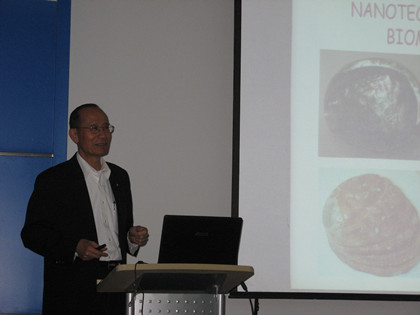|
|
| Oct. 23th, 2012, Prof. Ken P. Chong |
|
| Publishing Time:2012-10-23 |

Biography Prof. Ken P. Chong, P.E.earned hisAM, MSE, Ph.D. in Mechanics from Princeton University.He is aResearch Professorat the Mechanical & Aerospace Engineering Dept. of the George Washington University, and an Associate at NIST, writing a text book on Elasticity; editing an Elsevier structures journal, a new Taylor & Francis journal of Smart and Nano Materials and a Spon book series on structures and mechanics; serving on university boards, doing lectures, teaching, mentoring young professors, research, and consulting. He has beenthe Engineering Advisor and Director of Mechanics and Materialsfor the past 21 years at the National Science Foundation (NSF). He was the Interim Division Directorat NSF in 2005. He retired from NSF in 2010. He specializes in solid-mechanics/materials, nano-mechanics, and structural mechanics, including nano-technology, green engineering and sustainability.At NSF in addition to managing 120 university research projects in mechanics/materials, he was involved in the development of civil infrastructure systems, model-based simulation, non-destructive evaluation, structural control, durability and accelerated tests, life-cycle engineering, nano science and engineering, and other initiatives; established the NSF Summer Institute on Nano Mechanics/Materials at Northwestern University; co-created a new NSF program in Nano- & Bio-Mechanics and founded the Engineering Distinguished Lecture Series involving numerous Nobel laureates and distinguished speakers. Under his leadership the NSF Blue Ribbon Panel on Simulation-based Engineering Science [SBES, chaired by Tinsley Oden] was formed in 2005 and came up with bold recommendations in computational mechanics, simulation and other related areas. This effort is continuing at NSF with other Federal agencies. After he graduated from Princeton he was a senior research engineer at the National Steel Corp. for 5 years, during whichhe worked on building systems and pioneered the R&D of architectural sandwich-panel. Prior to joining NSF, he was a professorand chair of solid mechanics/structures at the University of Wyoming for 15 years;invented and developed new semi-circular bend (SCB) fracture specimens for brittle materials, now being considered as a test standard; built up graduate programs, experimental and computer facilities; developed new research programs funded by ERDA, DOE, DOD, NSF, AMF, etc and new courses; established joint seminars with Rocky Mountain universities. His experimental research on sweet spots in the 70’s changed the design of tennis rackets. He has published 200 plus technical papers and authored several books including 2 textbooks on mechanics by Wiley, in 3rdand 2ndeditions. He has given 50+ keynote lectures, received awards including the fellow of AAM, ASME, SEM, USACMand ASCE;Edmund Friedman Professional Recognition Award; Honorary Doctorate, Shanghai Univ.; DistinguishedMember, ASCE; NCKU Distinguished Alumnus Award; ASME 2011 Ted Belytschko Applied Mechanics Award, and the NSF highest Distinguished Service Award.He has been a visiting professor at MIT, U. of Washington – Seattle, U. of Houston, Dalian U. of Technology, Tsinghua U.; honorary professor at U. of Hong Kong, Hong Kong PolyU, Shanghai U. and others. He was invited by the founding President Prof. C. W. Woo as an academic consultant for the Hong Kong Univ. of Science & Technology, 1988-89, involved in the planning and design of the top modern research university. He delivered the Mindlin Lecture at Columbia Univ. in 2005, Sadowsky Lecture at RPI in 2006 and Raouf Lecture at US Naval Academy in 2012. He was a delegate at theUS-Israel Workshop on Sustainable Buildings, 2010, Technion, Israel; a facilitator of the Hong Kong Research Grants Council in 2010 to develop a major initiative on sustainability.Topic of Invited talk 1. Applied Research in George Washington University; 2. Converging Technologies and Multi-scale Mechanics; 3. Nano-technology in Civil Infrastructure; 4. Nano-technology in Civil Engineering Materials. |
|
|
|
|